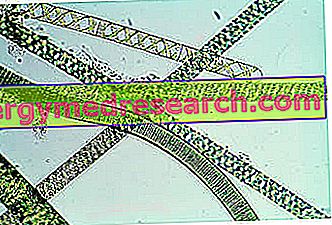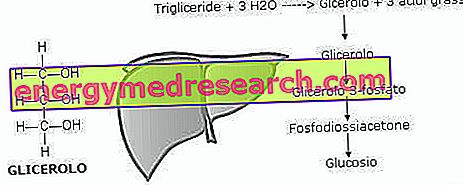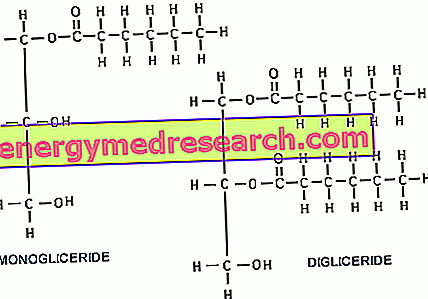Definition of Blue Algae
Among the unicellular prokaryotic and autotrophic bacteria the blue algae stand out, more commonly known as cyanobacteria and scientifically as Cyanobacteria, Cianofita, Mixoficee, Schizoficee or, again, Cianoficee. [from A. Bruni's Dictionary of herbal medicine and phytotherapy ]

General description
The blue (or green-blue) algae are commonly called such to recall their color, made from ficocyanina, a greenish or bluish pigment that perfectly camouflages the bright green color of chlorophyll; in addition to these pigments, in cyanobacteria it is possible to detect allopicocyanins and ficoeretrine, responsible, respectively, for the blue and red shades of the algae under examination. Again, among the other detectable pigments, we mention: zeaxanthin, β-carotene, mixoxanthophyll and echinone. [taken from //it.wikipedia.org/]
The blue algae represent the most ancient forms of life ever, dating back to the Precambrian period (corresponding to over 3 billion years ago): it is considered probable that the blue algae have conquered the primacy of being the very first colonizers of the Earth, in able to produce its own nourishment thanks to photosynthesis. Studies undertaken on fossils have highlighted important considerations: comparing the fossils of very ancient bacteria with others of blue algae (eg Ainimikiea) their particular similarity was observed. [taken from Le piante. Origin and evolution, by A. Garassino]
The blue algae have some fundamental peculiarities:
- Cyanophycin granules constitute the reserve substance: it is a compound characterized by aspartic acid (or asparagine) and arginine, two amino acids present in equal quantities.
- The blue algae, in symbiosis with the fungi, form lichens
- Blue algae fix atmospheric nitrogen in heterocysts, special cells used not only for nitrogen fixing but also for the conversion of elementary nitrogen into ammonia.
[taken from Botanical Plant Food, by C. Rinallo]
Botanical analysis
Over 2, 000 species of blue algae have now been identified, classified into 5 large systems according to their morphological structure. However, some authors do not approve the classification of algal species, as often happens, moreover, for many systematics of prokaryotic organisms.
We have seen that blue algae are prokaryotic unicellular microorganisms (without nucleus). The blue algae have a gram-negative cell wall. They live as single cells but, more often, they regroup forming real cellular aggregation colonies; so much so that the blue algae can be organized in branched, unbranched filamentary structures or in coenobia (small permanent or temporary colonies).
The blue algae have a tilacoidea membrane, in which photosynthesis takes place.
As for the red algae, also the blue ones contribute to the formation of carbonate platforms: thanks to photosynthesis, they remove carbon dioxide from the atmosphere, favoring the precipitation of calcium bicarbonate (CaCO 3 ).
As reserve substances, in addition to the aforementioned cianoficina, traces of polyphosphates (phosphorus reserve, known as volutin granules) and higher amounts of starch are also mentioned.
All the blue algae varieties are able to produce cyanotoxins (whose name derives from cyanobacteria): they are toxins useful to the same algae as a defense against other unicellular algae, protozoa or potentially dangerous microorganisms.
Sometimes, the ingestion of some toxins - undermined in fish or shellfish - could give a fatal outcome to humans (eg BMMA toxin, produced by blue algae belonging to the genus Nostoc ).
Blue algae: replication
The blue algae are ubiquitous aquatic organisms: they are found in thermal or cold waters, and in sweet or salted ones. Among the particularly favorable elements for the replication of blue algae we recall the alkalinity of the waters and the high temperatures.
Being prokaryotes, blue algae have asexual reproduction by fission.
Loans
Some species of cyanobacteria (eg. Arthrospira platensis, Arthrospira maxima Kütz, etc.) are cultivated for phytotherapeutic purposes: after cultivation and freeze-drying, blue algae can be used to formulate supplements, since some species represent a protein mine. Arthrospira platensis, in particular, is also exploited for its richness in mineral salts, vitamins and gamma-linolenic acid (essential fatty acid); this algal species also contains a modest amount of vitamin B12, not used in phytotherapy since it is in a non-bioavailable form.
Starting from some recent hypotheses formulated by the scientific community, it seems that the blue alga Arthrospira platensis (which together with Arthrospira maxima is found in supplements generically known as "spirulina") has potential antioxidant, immunostimulant and anticancer properties: in any case, yes they will have to wait for further confirmation as proof of the theory. The same applies to Aphanizomenon flos-aquae extracted from the upper Klamath lake.
Summary
| Blue algae: definition | Unicellular prokaryotic and autotrophic bacteria inserted in the order (taxon) of cyanobacteria, Kingdom Monere |
| Blue algae: synonyms | Cyanobacteria, Cianofita, Mixoficee, Schizoficee or Cianoficee |
| Blue algae: pigments |
|
| Blue algae: general description |
|
| Blue algae: botanical analysis |
|
| Blue algae: reserve substances and toxins |
|
| Blue algae: natural environment and replication |
|
| Blue algae: uses | Some species of cyanobacteria are cultivated for phytotherapy purposes: cultivation → lyophilization → formulation of protein supplements Arthrospira platensis : blue algae also exploited for its richness in mineral salts, vitamins and gamma-linolenic acid, to which potential antioxidant, immunostimulant and antitumor properties are ascribed |



